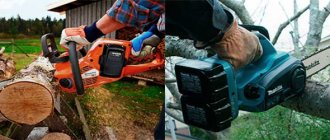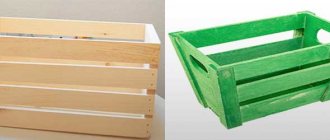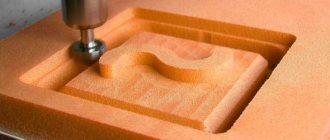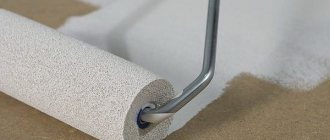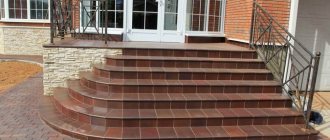To arrange the landscape design, I decided to build a beautiful gazebo, but since I had catastrophically little ready-made lumber, I decided to make it myself. I want to share with you the nuances of how the logs were cut into boards with a chainsaw with my own hands.
Source dorspetstekhnika.rf
Methods for cutting logs
Before sawing a piece, it is important to consider how to achieve a high-quality finished product with minimal waste. The wood is of uneven quality; the lower region of the core produces more expensive timber.
When sawing logs, you can obtain the following types of timber:
- Timber is a raw material whose dimensions are more than ten centimeters. The most popular type is a four-edged beam, which has a square shape when cut. It is used as a building material and in the manufacture of furniture;
- The board is a raw material, up to ten centimeters thick and twice as wide as the thickness. Boards are made from logs or beams and are used in construction and furniture production.
Having mastered the basic theory and practice, you can make boards and beams with your own hands.
Sawing map
The sawing map is a calculation of the optimal amount of finished lumber from one log. You can calculate it yourself for each specific log diameter, or you can use a computer program that greatly facilitates the calculation, and the price of which is quite affordable.
Material yield after cutting wood
Or the source could be a regular sawmill reference book. The result is a table that is used as a basis. The sawmill attachment should always be oriented to its data in order to obtain more lumber of any type of wood.
Advantages of sawing logs with a chainsaw
The saw and ax as woodworking tools are now gradually becoming a thing of the past, losing out to fairly powerful gas and electric saws.
A manual chain saw operates thanks to a two-stroke gasoline engine; the main component is a sharpened chain.
Main advantages:
- Superior efficiency, greatly simplifying human work;
- Mobility, it can be easily moved to other locations, put in a car, it does not work from the electrical network;
- Can be used at high levels of moisture and even during periods of precipitation;
- Ability to use a variety of attachments to perform a variety of tasks;
- Ease of operation;
- Reasonable cost compared to special woodworking machines.
Therefore, not only specialists with many years of experience prefer this product, but also owners of summer cottages are happy to use a chainsaw to solve daily problems in the garden and in construction.
Sawing schemes
You should decide on a work plan in advance.
One of the most important tasks of the sawyer is to choose the most rational cutting scheme. The compliance of materials with the goals set, the amount of output per unit volume of forest and, as a result, the profit of the enterprise will depend on this.
The master must have impressive experience and a special flair for the material in order to determine in advance the order of work, where to start and how exactly to act in the process. Such a skill comes only with time as a result of long work at the sawmill.
There are three standard log cutting schemes:
| Sawing diagram | Peculiarities |
| Circular | After removing the first slab, the log is turned over 180˚ and placed on the resulting edge. Then during the process it is turned over 180˚ or 90˚ more times, usually at least five turns are practiced. |
This is the most rational and economically beneficial method, however, in the absence of mechanisms for turning over when manual labor is used, the resulting productivity may be reduced
Log sawing tool
The selection of equipment for sawing workpieces is determined by many factors.
These include:
- Scope of work
- Dimensions of workpieces for cutting,
- Quality and volume of timber.
To cut large batches of workpieces and make more high-quality raw materials, it is recommended to use a sawmill. This is a wood processing unit, the functional part of which is a variety of saws.
The best option for longitudinal sawing of logs up to six meters long and with a diameter of 0.2-0.8 m.
At large woodworking plants with huge production batches, special points for sawing wood are used. You can cut logs of any diameter point by point, obtaining timber of the required parameters with a well-processed top layer. The lines are characterized by excellent efficiency.
For longitudinal cutting, you can make your own wooden stop - the main ruler that helps you cut the log perfectly. The stop consists of 2 wooden boards, one of which is fixed at the end in the central part of the other.
The structure is attached to the workpiece with self-tapping screws so that the outer edge of the vertical board is located below the outer border of the log. The interval between the top area of the log and the top area of the board calculates the thickness of the sawn slab.
Useful tips!
In order for sawing at the sawmill to proceed without any problems or complaints, you should pay attention to the following factors that may arise during the work process:
- Uniform feeding speed of material during operation;
- Correct blade shape;
- Carrying out the correct layout of the saw;
- Do not allow resinous substances to stick to the canvas;
- Watch the saw teeth.
Types of working attachments
If necessary, the workpiece is sawed into boards with a chainsaw using special attachments. The frame for a gasoline saw is fixed to the structure and is designed to guarantee smooth movement when cutting workpieces horizontally.
The structure includes:
- The main frame moving along the outer layer, next to which it is necessary to saw the wood;
- A vertical stand where the material thickness adjustment system is fixed;
- Thickness adjustment system containing knobs for adjustment and a bolt that sets the required circumference;
The ability to set the exact diameter and competent cutting of the log helps to obtain boards of identical thickness and reduce the amount of waste. To cut wood for the first time, you need a main frame or a flat, straight board.
As an analogy, you can make a smooth foundation covering using an ax, an electric plane and a level. During further sawing, the main surface is the flat part of the board obtained during the previous work.
Safety rules to follow
It is better not to approach the process of sawing firewood without preparation. Before work, I studied a number of safety requirements, which I am happy to share with you:
- First of all, I made sure that the gasoline saw was ready for use and assessed whether the attachment was installed correctly. To determine the presence of an error, you can initially make a drawing, which can then be used to construct a guide.
- I prepared the place and checked the reliability of fastening of all the parts, because if something gets unscrewed during the cutting process, it will not only have an incorrect effect on the lumber, but can also be dangerous to health.
- He put on overalls and a protective transparent mask. At this stage, I also advise you to use assembly gloves to protect your hands from splinters and accidental cuts from wood knots.
- I prepared a first aid kit in case I needed to give myself first aid. I put peroxide, a bandage, a cotton swab, and brilliant green into it.
Source arbeiterkammer.at
I recommend not to neglect any of the listed rules, because the result of preparing lumber depends on their compliance.
Chainsaw sawing technique
Before turning a log into boards at home, you need to cut it correctly in order to get the largest batch of high-quality boards with the least amount of waste.
Markings are made on the wood that correspond to the specified task and the appearance of the intended timber.
- Before starting work, you need to fix the workpiece well in order to achieve excellent quality of covering the boards. Sawing of logs is carried out mainly horizontally.
- You can cut the workpiece along the chainsaw using equipment for longitudinal sawing - a wooden stop - a structure made by yourself.
- When using a rip saw attachment, you need to securely fix it to the chainsaw frame. Before starting work, you need to worry about making the base coating, which will be used for sawing with a chainsaw.
Wedges are placed in the longitudinal cut to prevent the sawn edge of the board from pinching the parts of the chainsaw. The unit must move slowly and do not press on it.
It is recommended that two people take on the task of sawing logs, since additional hands will be needed to move and fix the workpiece in order to place the wedges in the cut.
Benefits of the DIY Process
If the household has a chainsaw, then with its help you can cut the logs with the highest quality. Moreover, working with this tool has a number of worthy qualities, which I discuss below:
- Maximum performance. That is, in a short period of time you can make several cubes of lumber.
- You can always use different attachments for fragmenting logs, depending on the required dimensions of the source material.
- Ease of use and no need for regular maintenance, such as in electric models.
- Safe operation in damp conditions, even with precipitation (however, this will not be very good for the log).
- Mobility. The device is not connected to an electrical outlet, so you can easily take it with you on the road and transport it in your hands.
It is also possible to use specialized attachments for chainsaws, which I will discuss below.
Source vosadu-li-vogorode.ru
Photo instructions on how to cut logs into boards
Tsulaga
When processing small workpieces, the tsulaga shown in the pictures below can be of great help.
To make it, you will need a piece of wood slab approximately 20 x 30 cm in size and 2 mm thick, as well as two planed strips, which must be fixed to the slab as shown in the figure. To prevent the slab from bending and breaking, the planks must be positioned transverse to the direction of its core layer.
How to work with a circular saw
The lower bar of the tsulaga rests against the edge of the tabletop and thus sets the correct direction for the cut; the shortened upper bar ensures good centering of the saw.
If you have to saw long boards or planks, then a second tsulaga will not hurt, which will serve as a stop for the other end of the workpiece.
A piece of wood slab and two pieces of plank are enough to make a practical tsulagi.
Before starting sawing, the saw placed at an angle must be pulled towards you several times.
What to consider when felling trees near your home
It is quite difficult to cut down vegetation, including large trees, growing around houses. Such an event requires a special technology. The following factors may indicate the need for felling:
- the stem part is located at an angle of more than 45 degrees;
- the plant has a tall and thin trunk;
- there are cracks and hollows or rotten areas.
Buildings and structures located in close proximity, electrical communications and utility networks often greatly limit the area of work. In this case, preference is most often given to felling not entirely, but in parts, by hanging and lowering already cut elements. This option requires the mandatory use of special equipment or tying and lowering the cut fragments using nearby trees.
After cutting, a stump remains, which is most often removed by uprooting, which allows for high-quality leveling of the soil surface on the site. To reduce labor costs for such activities, it is recommended to fell trees by cutting off the roots. This cutting is not done directly, but at an angle to the direction of root growth. You need to dig up the roots with a shovel, having first removed the bark from the top of the roots and tapped the soil, which will reduce the risk of the ax becoming dull during the cutting process.
Felling trees with an ax and a regular saw has been used less and less recently, which is due to the availability of electric and chainsaws among country property owners. However, in particularly difficult cases, it is advisable to seek help from specialists who, using special equipment, perform such work very quickly and as efficiently as possible.
A chainsaw with the proper power is capable of cutting down any tree trunk for which the length of the cutting part is sufficient. You need to carry out the work very carefully, adhering to all the rules
Particular attention should be paid when there is a risk of unpleasant situations due to too thick, icy or contaminated wood. You need to take into account all the factors that can complicate the work, and use the chainsaw carefully, constantly monitoring your actions and the work of your partners
In the article we will talk about how to properly cut down a tree with a chainsaw - diagram and instructions.
Preparing for sawing or felling
Any mature tree, large or small, even if it grows near a house on a private plot, is protected by law.
Therefore, before cutting it down, you need to get a felling ticket.
After this, you need to determine the state of the tree and choose a method for its removal, taking into account:
- physical capabilities;
- equipment availability;
- experience in the field of tree felling.
Physical capabilities
To remove a tree, you need good:
- coordination of movements;
- endurance;
- force;
- flexibility.
If you have a problem with any of these parameters, it is better to invite a specialist.
Problems with endurance will lead to the fact that after each performed action you will have to rest, while the tree will be in an unstable state and can fall in any direction.
Lack of strength will prevent you from using an ax and chainsaw effectively, and problems with flexibility will force you to use all tools in an awkward position, which dramatically increases the likelihood of mistakes and injury.
Equipment
The main tool needed for any method of cutting down a tree is a chainsaw.
If it is not there, you can use
- axe;
- two-handed saw;
- hand saw (large-toothed wood saw).
Under no circumstances should you use a grinder (angle grinder) or any discs, because the wood will clamp the disc, after which the tool will be torn out of your hands, and given the enormous speed of rotation of the disc and the high power of the motor, serious injuries are possible. Also, you should not use a hacksaw for metal, because its shape and blade are not intended for such work.
Without a chainsaw, the process of felling a tree will require much more effort, and the likelihood of errors will also increase.
To cut down wood with a guy wire, a winch and door springs are useful, which can be replaced with a rubber band or tube.
For cutting with dropping or hanging, you will need strong ropes or cords with a diameter of 7–10 mm, which can be purchased at hardware or sports stores.
You will also need a mounting belt or a climbing harness, and the latter is preferable, because it will stop the body more gently when falling.
It is necessary to purchase various blocks and carabiners in construction or sports stores. When cutting down large trees, an aluminum folding ladder with a wide cross stop at the bottom is very useful.
Preparing for work
The first thing to start working with a chainsaw is its assembly.
The assembly diagram of different models is practically the same. The saw bar and chain are installed on the saw, and the chain is tensioned. The chain can be considered correctly tensioned if it does not sag on the bar and can be easily turned by hand. If you have to apply too much force to turn the chain, it means it is too tight and you should loosen its tension a little.
Next, you need to check the sharpening of the chain; for this, the cutting edge of each working tooth is visually inspected. The edges must be smooth without dents or nicks.
The next step is refueling the chainsaw. The fuel mixture is prepared in a certain proportion, which can be found by reading the user manual supplied with the saw. Basically, the fuel mixture is diluted in a ratio of 1:50, that is, for one liter of AI-92 gasoline, you need to add 20 grams of oil for two-stroke engines.
Important: when pouring fuel and oil for chain lubrication into the tanks, you need to be extremely careful and not mix them up. If you pour oil into the fuel mixture tank, the chainsaw will not work.
To restore functionality, you will need to flush the fuel tank with gasoline, as well as clean the fuel line and carburetor, which is quite difficult.
HOW TO MAKE A PERFECT STRAIGHT CUT WHEN ASSEMBLYING A FRAME
If you are not a tough frame construction professional, then you most likely have problems with straight cutting with a manual circular saw.
A good, even cut is very desirable when assembling a frame. Even if you have a laser-guided saw, it still takes skill and a steady hand.
Usually, for a straight long cut, they use a cord rubbed with chalk: they beat off a straight line with it and saw along it. But if you don’t have the skill, this doesn’t really help. It is good to have a rigid guide against which the edge of the saw rests - then the cut should be straight. To do this, I had to come up with equipment from what was at hand.
Stages of work
To cut a workpiece quickly, you need to proceed in stages:
Take a board of the required size and decide on the tool. If the workpiece is large, you should use a hacksaw with large teeth. For smaller wood materials, use a saw with smaller teeth. The necessary markings are applied with a pencil and ruler. Draw lines that are barely visible to the naked eye. You need to follow the well-known proverb: “Measure twice, cut once.” First make a drink. To prevent the canvas from wobbling, experts advise holding it with your thumb or a special device called a miter box. This makes the procedure much easier. Cut the wood straight, do not sway the body of the tool from side to side
If the hacksaw gets stuck in the material, carefully release it and try cutting again.
If you follow the recommendations, the procedure will go without problems. No special skills are needed to implement it. Anyone can cut the material.
Key Operating Principles
The chainsaw is always held with both hands, tightly gripping the handle with all fingers (the thumb of the left hand should be located under the front handle). The saw should be placed closer to the body - this way the arm muscles will tire less (there is no need to be afraid of the proximity of the saw). In addition, in this position it will be easier to maintain balance and maintain full control over the process.
Your legs should be spread wide, with your knees bent for stability, but your back should be kept straight. If the mechanic needs to change position, he must first turn off the engine by activating the brake. If you need to move the chainsaw over a considerable distance, it is recommended to cover the tire with a casing.
It is better to learn to use a chainsaw on horizontal, not too thick logs at first. Once you feel confident and strong in your hands, you can learn to fell trees. To cut logs or beams straight, you need to make marks with a pencil and then gradually move along these marks. It’s good if you have the opportunity to watch how experienced sawyers work.
Preparation stage
Before cutting down a tree, you should make sure that surrounding objects (railway rails, buildings, power lines, highways, etc.) will not be damaged as a result of the falling trunk. There should be nothing unnecessary within a distance of two lengths of the tree being cut in any direction. In addition, if the place is crowded, then it is necessary to use warning signs - this is a must.
Pay attention to the following points:
- whether the tree grows straight or not;
- is there a slope of the soil;
- what is the strength of the wind and in which direction does it blow.
This ultimately determines in which direction the trunk will fall. You need to be especially careful with rotten, dry wood. It may behave unpredictably for the lumberjack and may not fall as planned. A damaged tree can be identified by external signs (dry branches, damaged trunk). Experienced fellers determine the quality of wood by tapping the trunk - a healthy tree “rings”, while a sick tree sounds dull or inaudible.
The ground around the tree must be cleared of bushes and other growth - this is another important preparatory action. It is necessary to remove everything that could impede the safe movement of the master with the chainsaw during the felling process.
How to saw
The sawing procedure itself usually goes like this. The lumberjack stands to the right of the trunk and makes a guide cut on the natural slope side at a 45-degree angle to a depth equal to about a quarter of the tree's diameter. This undercut should be as low as possible - this will make it easier to fell the trunk (and the stump will not be too high). It is also worth keeping in mind that the undercut seems to indicate in which direction the tree will subsequently fall to the ground.
A horizontal cut is then made on the opposite side of the tree—the main felling cut. There should be some small distance between it and the inclined undercut - this gap is needed so that the tree does not collapse prematurely.
During the work, it is necessary to monitor where the trunk is tilting in order to have time to react if something goes wrong. When the tree begins to fall, you need to quickly remove the chainsaw from the cut, turn off the engine and leave the dangerous place.
If, having caught on another trunk during felling, the tree does not fall completely, then professional help will be required. Leaving it unattended, as well as trying to correct the situation on your own, is prohibited.
There are times when a chainsaw bar gets stuck in the trunk. There is no need to panic and suddenly pull it out, especially if the tool is in working condition. First of all, you need to stop the engine. And then you should manually tilt the barrel little by little until the chainsaw slips out.
Work sequence
Preparation for the main job begins with studying the safety requirements:
- checking the correct sharpening of the saw chain and the serviceability of the chainsaw as a whole;
- selection of comfortable shoes, clothing and protective equipment, the minimum list of which includes glasses and mittens.
At the second stage, it is necessary to calculate different options for the trajectory of the fall of the trunk with minimal damage to the surrounding area.
The following mandatory factors must be taken into account in the calculations:
- tire length;
- engine traction characteristics;
- trunk thickness, wind strength and direction.
- The felling of large trees in the coastal zone requires careful preparation. Sawing a trunk that has fallen into the water creates many problems, the solution of which will require additional investment.
- You should also decide on escape routes if the situation gets out of control. The felled tree still needs to be sawed and removed, so it is advisable to provide fairly convenient access to the place where the trunk is cut.
- When felling large trees, the risk of large branches falling should be avoided. The problem in each specific case is solved individually, in the best case - by renting an articulated lift or paying for the services of an industrial climber. The information received from experienced sawyers will help you avoid mistakes that are typical for the first trial of strength.
- When preparing the workplace for safe approach and movement, it is necessary to clear the surrounding area of branches, leaves and other foreign objects.
We invite you to familiarize yourself with Fir: distribution, types, care, reproduction, diseases The use of single-cut cutting of a trunk in amateur sawing practice is justified only when felling trees of moderate height and small, within 100-150 mm, diameter. Working with thick trunks requires compliance with the requirements of standard technology.
- The first upper cut is made from the side of the planned laying of the trunk at an angle of 45 degrees and to a depth of up to a quarter of its diameter. The bottom cut is made horizontally until both cuts meet.
- The most critical stage of the work is the felling cut, which is performed from the side opposite to the place where the felled tree is laid. Before you begin, you need to once again make sure that there are no people or animals in the surrounding area, check that you have a secure grip on the tool, and take a position that is comfortable for work.
- The felling cut is made parallel to the bottom one, 50 mm lower. The technology dictates that the cut is approximately 1/10th of the diameter of the trunk, which is used as a kind of hinge.
If the requirements for the size of the undercut, the location of the guide and felling cuts are not met, the direction of the tree's fall, especially in windy weather, may become unpredictable.

